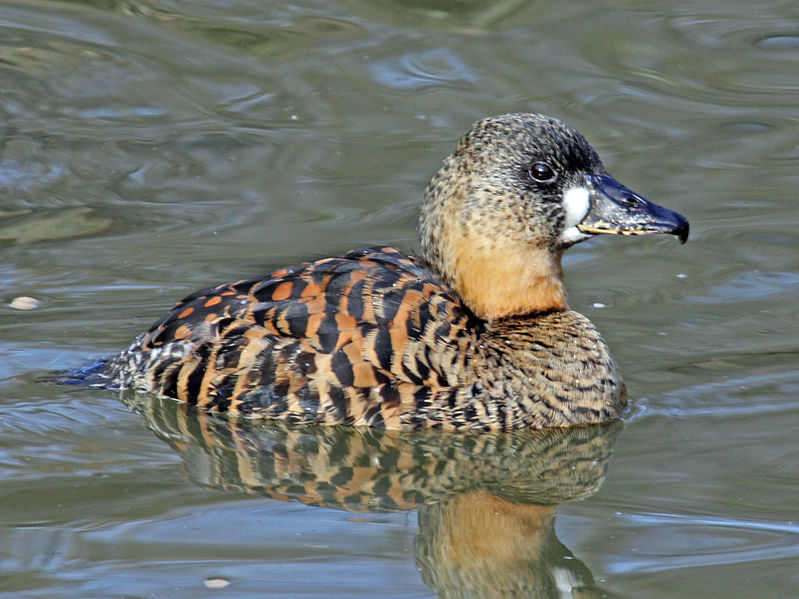
White-backed duck(Thalassornis leuconotus)
Phylum —chordata
Class — aves
Order — anseriformes
Family — anatidae
Genus –thalassornis
Appearance
The male has a buff neck and cheeks merging into a speckled dark crown and nape. The eyes are brown, the bill is black with yellow blotches and a white patch either side of its base. The breast and under-parts are buff with barring and the upper-parts and flanks are buff with broader barring. The lower back is white, the rump and tail are black, the flight feathers are light brown and the coverts are dark brown with buff and white markings. The legs and feet are green/grey.The female is similar to the male.
Size – 380 to 400 mm.
Habitat
White-backed ducks live in Africa, especially between Senegal and Chad in the west, Ethiopia in the east, and South Africa in the south. Their habitat consists of lakes, ponds, swamps and marshes where they are well camouflaged against predators.
Behavior
White-backed ducks blend in exceptionally well with the water lilies, on first glance at a suitable lake or dam they are invariably not noticed as they sit motionless among the lily pads but if you scan the water with binoculars you will see them. They appear to make no attempt to hide or fly off relying on their ability to blend in with the lily pads while remaining motionless. They rarely venture on to land.
Diet
Most bodies of water in tropical Africa are carpeted in various species of water lily Nymphaea, the leaves and seeds of these plants provide the white-backed ducks with most of their dietary requirements.
Reproduction
Breeding season is year-round.
Nest is built by both sexes and is located in a dense stand of reeds or rushes or grasses or sedges growing in the water. The nest can be floating or built up on the vegetation to as high as 45 cm above water level. The nest itself consists of a bowl of dead or living plant material drawn in from around the site and padded with green aquatic grass.
The female lays a clutch of 4-9 eggs at a rate of one per day. After the clutch has been completed, both sexes incubate the eggs for 29-33 days before they hatch. The female incubates at night and for about an hour in the middle of the day, and the male incubates for the remainder of the day. Nest changeover is communicated through an exchange of calls and a bird usually approaches the nest underwater.
Ducklings are able to swim, dive and feed within 20 hours of hatching. They are 50% of adult size by 27 days old; by 34 days they have all their feathers except for some wing feathers, and by 55 days they look exactly like the adult. The adults accompany the brood until at least fully grown and are highly protective of them.
Incaptivity
White-backed ducks have never been particularly common in captivity, they are easy to maintain and long lived but the young can be a challenge to rear.
Unlike most waterfowl they are notoriously difficult to vent sex so there have probably been many instances in the past where an assumed pair are in fact birds of the same sex that is not conducive to a growing population. With such a rare species DNA sexing is advised.
The diet of captive white-backed ducks is very simple: they will take pellets as long as they are available close to the water’s edge, they also eat with relish most of the floating waterfowl pellets and they absolutely adore wheat and various millets. Note that given the choice they would probably feed on nothing other than millet and they will thrive but it has been suggested that this diet makes them fat and may cause infertility.
White-backed ducks are easy to maintain on a large piece of natural water but also work very well on relatively small artificial ponds.It is perhaps the smaller enclosures that provide observation at close quarters that allows the character of the white-backed ducks to really be appreciated. The patterns of their plumage are very appealing at close quarters and they are also surprising vocal with their range of interesting whistles and should you surprise them or encroach to closely they will also hiss quite loudly as they indignantly give ground. Another trait of the species is to loaf either on the water or at the water’s edge with their very large feet resting on their backs which is certainly surprising when you first observe it.
Provided there is cover close to the water white-backed ducks will happily construct their own nest. This is an impressive construction completed by both members of the pair. If cover is not available, they may be tempted to use an open fronted ground box.
Once nest construction has started it is not difficult to locate the nest because if you encroach to closely the pair will rush to the site and defend with much hissing and aggressive threat postures.
 Russian
Russian
 English
English
























